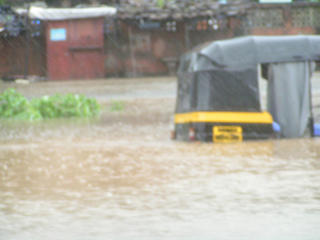Is Cloudburst involved with this?
***Municipal Commissioner, Mr. Johny Joseph, had called a meeting of NGOs on 4th Aug at BMC. About 20 NGOs and 15 BMC officials were present.
An NGO Co-ordination committee for flood relief was formed.
The committee would act as a clearing house to convey info from the field to BMC and vice versa. The info would be to and from NGOs, donors, and all supporters.
- NGOs should give all possible feedback twice a day of the actual situation in their areas - materials needed, services needed, where the govt machinery has not reached, what all needs to be done, what are the problems being faced, a report on the situation.
- If NGOs have any questions regarding govt reliefs or procedures or announcements, they should ask those also.
- All offers from donors, volunteers, etc. of money, material, services, and manpower should also be conveyed to BMC.
BMC, in turn, will do the following:
- follow-up with the ward officers and other govt resources at their disposal
- co-ordinate with donors and corporates to help out urgently
- give clarifications about the procedures and also ensure that relief measures are implemented without delay or friction
The Coordination Committee will consist of:
- Ms. Farida Lambay of Nirmala Niketan, who will co-ordinate with all NGOs for Western Suburbs i.e. all H, K, P and R wards.
- Ms. Leena Joshi of Apnalaya, who along with TISS will co-ordinate with all NGOs for Eastern Suburbs i.e. all L and M wards
- Mr. Dinesh Kakkoth of CRY 23096845 / 6472 and Dr. Medha Somaiya of Yuvak Pratisthan who will co-ordinate with NGOs for the Central Suburbs i.e. all N, S and T wards.
- Ms. Armida Fernandes of Sneha or 24042627 who will co-ordinate with NGOs for F-north and G-north wards.
- Mr. Begur of Unicef 28269727 / 28253663 X 103 who are mapping the detailed needs of the 7 most affected wards and co-ordinating with various international NGOs.
- Times Foundation timesfoundation@timesgroup.com Helpline: 56354376 / 45 who will also disseminate the official info via the newspapers and radio.
- Vinay Somani of Karmayog which will post all needs and offers on the Flooding section
at Karmayog.com along with all FAQs, queries of NGOs and clarifications by BMC, other info by BMC, etc.
All NGOs and all others are requested to convey their info or qs to any person above who they think would be most suitable for their problem. They will then co-ordinate with BMC.
Everyone can also convey directly to the BMC Disaster Control Room: Phone: 1916 or 108 or 22694725 / 7 or Fax 22694719. Needs and Offers can be emailed to ccrs@vsnl.net. Complaints can be also posted online via
Praja as these are being monitored continuously and also simultaneously go to the ward office.
Do feel free to contact us at Karmayog via email info@karmayog.com.
I understand that many are sceptical of the BMC responding to specific problems but I do think that we all should seriously try out this concept of a Co-ordination Committee.
If you would like to be in or to help the committee, do email me.
Regards
Vinay
www.karmayog.com
______________________________________________
Karmayog mailing list
Karmayog@karmayog.com
http://seven.pairlist.net/mailman/listinfo/karmayog





